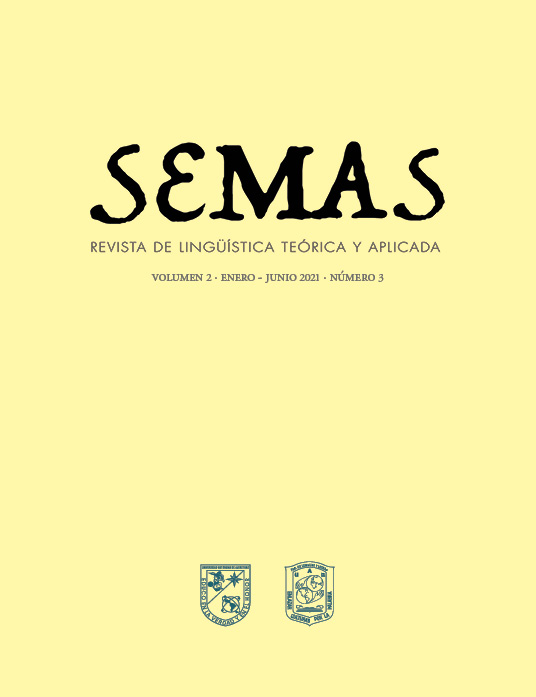Abstract
In the last decades, studies on metaphor and metonymy have increased. These phe-nomena have been understood not as style resources, but as conceptual mechanisms. Lakoff and Johnson’s book (1980) triggered this novel conception of metaphor and all the subsequent theoretical developments. One of the paths that these inquiries have travelled is the analysis of various metaphors in corpora belonging to different discourse genres. In this paper, some metaphors and metonymies on the COVID-19 pandemic and the quarantine situation are studied; they were taken from texts published in the social networks. This paper analyses different metaphors and metonyms that project the domains of soccer, religion, war, navigation and computing, among others. Also, different types of personification are explored.
References
Abralin [Abralin]. (2020). “Metáfora, cognición y emoción: reflexiones en tiempos de pandemia” [Video]. Recuperado de: https://youtu.be/MBsPqwGjIlM
Badiou, A. (2008). “La danza como metáfora del pensamiento”. Revista Fractal, 50, pp. 15-36.
Barcelona Sánchez, A. (1997). “Clarifying and Applying the Notions of Metaphor and Metonymy withing Cognitive Linguistics”. Atlantis, 19(1), pp. 21-48.
Boff, L. (2017). A águia e a galinha: uma metáfora da condição humana. Petrópolis: Editora Vozes Limitada.Caballero, R. (11 de abril de 2020). “Memes sobre la extensión de la cuarentena”. 100.9 Radio Chalet. Recuperado de: http://fmchalet.org/memes-sobre-la-exten-sion-de-la-cuarentena/
Cuenca, M. y Hilferty, J. (1999). Introducción a la Lingüística Cognitiva. Barcelona: Ariel.
Di Stefano, M. (Coord.). (2006). Metáforas en uso. Buenos Aires: Biblos.
Ferrero, A. y Roas, S. (2011). “El ‘zombi’ como metáfora (contra)cultural Nómadas”. Critical Journal of Social and Juridical Sciences, 32(4). Recuperado de: https://www.redalyc.org/articulo.oa?id=181/18120706008
Dirven, R. y Ruiz de Mendoza Ibáñez, F. (2010). “Looking back at thirty Years of Cognitive Linguistics”. En E. Tabakowska, M. Choinski, & L. Wirszaka (Eds.), Cognitive Linguistics in Action (pp. 11-70). Berlin/New York: Mouton de Gruyter.
Drozdz, G. (2014a). “The Development of the Theory of Metonymy in Cognitive Linguistics”. Linguistica Silesiana, 35, pp. 119 -151.
Drozdz, G. (2014b). “Metonymic extension as the process underlying the change of count and mass properties of nouns”. In Andrzej Lyda (Ed.) Extension and its Limits (pp. 80-107). Newcastle: Cambridge Scholars Publishing.
García, J. (2006). La diosa Fortuna: metamorfosis de una metáfora política. Madrid: Antonio Machado Libros.
Gonzalez, D. (Ed.). (2018). Análisis interdisciplinar de objetos culturales sobre problemáticas sociales. München: GRIN.
Goossens, L. (1990). “Metaphtonymy: The Interaction of Metaphor and Metonymy in Expressions for Linguistic Action”. Cognitive Linguistics, I(3), pp. 323-340.
Lakoff, G. (1987). Women, Fire and Dangerous Things. What Categories Reveal about the Mind. Chicago/Londres: University of Chicago Press.
Lakoff, G. (1991). “Metaphor and War: The Metaphor System Used to Justify War in the Gulf ”. Peace Research, 23, pp. 25-32.
Lakoff, G. y Johnson, M. (2001 [1986]). Metáforas de la vida cotidiana. Madrid: Cátedra.
Lefdahl-Davis, E.; Stefan, D.; Huffman, L. & Alayan, A. (2020). “Positive Psychology During a Pandemic: REFRAME for Well Being”. European Journal of Applied Positive Psychology, 4, Article 18, pp. 1-15.
Lizcano, E. (1999). “La metáfora como analizador social”. EMPIRIA. Revista de Metodología de Ciencias Sociales, 2, pp. 29-60.
Martínez, F.; García Cumbreras, S.; Díaz Galiano, M. y Montejo Ráez, A. (2014). “Etiquetado de metáforas lingüísticas en un conjunto de documentos en español”. Procesamiento del Lenguaje Natural, 53, pp. 35-42.
Moreno, I. (2009). Estudio cognitivo de un corpus de metáforas sobre el “proceso de paz”. En P. Cantos Gómez & A. Sánchez Pérez (Eds.), A survey of corpus-based research (pp. 518-533). Recuperado de: https://dialnet.unirioja.es/servlet/articulo?codigo=4805600&orden=1&info=link
Nuyts, J. (2004). “The cognitive-pragmatic approach”. Intercultural Pragmatics, 1, pp. 135-149. OPLAS. (11 de abril de 2020). “Humberto Maturana: yo creo que no podemos tratar a la pandemia como un enemigo”. Observatorio plurinacional de aguas. Recuperado de: https://oplas.org/sitio/tag/humberto-maturana/
Pagnini, F.; Bonalda, E.; Montrasi, E.; Toselli, E. y Alessandro, A. (2020). “Reframing the psychological impact of the COVID-19 outbreak through a social media community for students”. PsyArXiv. Recuperado de: https://doi.org/10.31234/osf.io/d5wph
Panther, K.; Thornburg, L. & Barcelona, A. (Eds.). (2009). Metonymy and Metaphor in Grammar. Amsterdam/Philadelphia: John Benjamins.
Pérez Salazar, G; Aguilar Edwards, A. y Guillermo Archilla, M. (2014). “El meme en internet: Usos sociales, reinterpretación y significados, a partir de Harlem Shake”. Argumentos (México, DF), 27(75), pp. 79-100.
Rajandran, K. (2020). “‘A Long Battle Ahead’: Malaysian and Singaporean Prime Ministers Employ War Metaphors for COVID-19”. GEMA Online® Journal of Language Studies, 20(3), pp. 261-267.Santo Padre Francisco. (27 de marzo de 2020). “Urbi et Orbi. Momento extraordinario de oración en tiempos de epidemia. La Santa Sede. Recuperado de: http://www.vatican.va/content/francesco/es/messages/urbi/documents/papa-francesco_20200327_urbi-et-orbi-epidemia.html
Sheedy, K. (2020). “Reframing the Humanities: COVID-19 May Flip the Script on Overshadowed Human Experiences”.New England Journal of Higher Education. Recuperado de: https://nebhe.org/journal/reframing-the-humanities-covid-19-may-flip-the-script-on-overshadowed-human-experiences/
Villegas, M. (1993). “Las disciplinas del discurso: hermenéutica, semiótica y análisis textual”. Anuario de psicología, 59(1993), pp. 19-60.

This work is licensed under a Creative Commons Attribution 4.0 International License.
Copyright (c) 2021 Semas

